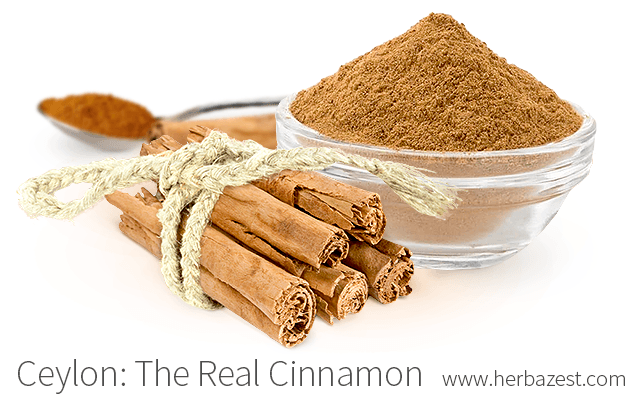Over the thousands of years of cultivation, many varieties and types of cinnamon have been developed, each possessing numerous names and different characteristics. Real cinnamon is botanically known as Cinnamomum verum or Cinnamomum zeylanicum and popularly called true cinnamon, dalchini - Hindi name - and Ceylon cinnamon. This type of cinnamon can be identified by its origins, flavor, appearance, and health benefits.
Where Does True Cinnamon Come From?
Real cinnamon is native to Sri Lanka - formerly known as Ceylon – where it is still cultivated on a large scale. It is also grown in other humid, semi-tropical regions, such as Seychelles and Madagascar islands, Mexico, and part of South America.
The Ceylon cinnamon tree is an evergreen that grows between 33-49 feet (10-15 m) tall and is easily identified by its shiny leaves and small, white flowers. Commercial true cinnamon sticks - as well as cinnamon extract and cinnamon oil - are derived from the bark of C. verum.
How to Identify Real Cinnamon
It is common for Chinese cinnamon - also known as cassia cinnamon - to be disguised as true cinnamon. Cinnamon supplements and ground cinnamon are also often sold as a combination of true cinnamon and cassia cinnamon. This is because true cinnamon is more expensive, rarer, and highly preferred by chefs and bakers. For these reasons, it can be difficult to identify it; however, certain characteristics will help distinguish it from its Chinese counterpart.
True cinnamon - Ceylon cinnamon - is lighter in color with a medium reddish-brown shade, compared to cassia's dark reddish-brown hue. The flavor of real cinnamon is milder and sweeter than cassia, which is known for having a spicy, slightly harsh taste.
The essential oils of real cinnamon and cassia vary based on their main active ingredient. The main active ingredient in cinnamon essential oil is eugenol, while that of cassia is cinnamaldehyde.
The eugenol in true cinnamon is responsible for its clove-like aroma.
Examining cinnamon quills can be another telling factor. True cinnamon has slender, thin quills with smooth surfaces, while cassia cinnamon has denser quills, with rough surfaces.
Ceylon Cinnamon Benefits
The benefits of dalchini, or Ceylon cinnamon spice, are plenty, and the plant is used with medicinal, culinary, and cosmetic purposes. Real cinnamon is popular for preventing and treating numerous health conditions, due to its antioxidant, anti-inflammatory, anti-bacterial, and anti-fungal properties.
Ceylon cinnamon's health benefits include improving cardiovascular health, fighting off infections, and aiding weight loss. Studies have also revealed other benefits of dalchini, such as lowering blood sugar, cholesterol, and regulating blood pressure.1,2,3
One major benefit linked to the consumption of true cinnamon rather than cassia is its lower content of coumarin, which is a toxin that can cause liver damage when consumed in large amounts. The levels of coumarin in real cinnamon are considered harmless; however, cassia cinnamon contains larger doses of this compound.
Dalchini's benefits are popularly enjoyed in South Asian, English, Mexican, Central American, and South American cuisines. Its versatility allows it to be complementary to sweet and savory dishes, while also replacing flavor enhancers that are generally high in fat.
Additionally, true cinnamon's essential oil is commonly used in cosmetic products, such as soaps, body washes, scrubs, moisturizers, and massage oils as well as insect repellents. This is due to its antioxidant, anti-inflammatory, and anti-bacterial properties as well as its ability to work as a natural anesthetic.
Widely recognized as the best cinnamon, its origin, flavor, texture, oil content, and health benefits can help identify Ceylon, true cinnamon from the other varieties.
Sources
- Cinnamon and Cassia: The Genus Cinnamomum, p. 1
- Food Flavors: Chemical, Sensory and Technological Properties, p. 207
- Forgotten Skills of Backyard Herbal Healing and Family Health
- Handbook of Spices, Seasonings, and Flavorings, pp. 93-96
- Louisiana State University, Cinnamon
- Spices and Seasonings: A Food Technology Handbook, pp. 69-70
- The Complete Book on Spices & Condiments, pp. 71-73
- Kew Royal Botanic Gardens, Cinnamon – a festive favorite
Footnotes:
- Molecules. (2021). Absolute Antioxidant Activity of Five Phenol-Rich Essential Oils. Retrieved November 19, 2021, from: https://www.mdpi.com/1420-3049/26/17/5237
- Journal of Essential Oil Research. (2011). Correlation of Antimicrobial Activities of Various Essential Oils and Their Main Aromatic Volatile Constituents. Retrieved November 19, 2021, from: https://www.tandfonline.com/doi/abs/10.1080/10412905.2009.9700218
- Food & Fuction. (2021). Effects of the polyphenol content on the anti-diabetic activity of Cinnamomum zeylanicum extracts. Retrieved November 19, 2021, from: https://pubs.rsc.org/en/content/articlelanding/2014/fo/c4fo00130c/unauth
- Oriental Journal of Chemistry. (2016). Evaluation of Antifungal and Antibacterial Activity and Analysis of Bioactive Phytochemical Compounds of Cinnamomum zeylanicum (Cinnamon bark). Retrieved November 19, 2021, from: http://qu.edu.iq/repository/wp-content/uploads/2017/01/9%D9%84-ilovepdf-compressed.pdf
- Journal of Microbiology, Biotechnology and Food Sciences. (2018). Extraction and identification of essential oil from Cinnamomum zeylanicum barks and study the antibacterial activity. Retrieved November 19, 2021, from: https://www.jmbfs.org/jmbfs-271-al-fekaiki/?issue_id=4649&article_id=16




